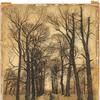Tom Sachs: Tea Ceremony Transforms Noguchi Museum Galleries with Artist’s Unique Twist on Traditional Tea Ceremony
- LONG ISLAND CITY, New York
- /
- March 23, 2016
The Noguchi Museum’s thirtieth-anniversary programming culminates this spring with Tom Sachs: Tea Ceremony, a major project by the internationally celebrated artist. The exhibition, which represents Sachs’ distinctive, irreverent-but-respectful take on the rituals and accoutrements of chanoyu, or traditional Japanese tea ceremony, confirms his status as one of the leading artists of our day, as well as the ultimate master of cultural bricolage—the practice of creating things from a variety of available materials and objects.
Tom Sachs: Tea Ceremony centers on an immersive environment that includes the myriad elements—all crafted by the artist and his studio—that are essential to tea ceremony’s intensely ritualistic universe. These are amplified by displays in adjoining galleries of a rich selection of other materials borrowed from the artist, related to both chanoyu and Sachs’ landmark, ongoing project titled Space Program, of which Tea Ceremony has become an integral extension.
Tom Sachs: Tea Ceremony centers on an immersive environment that includes the myriad elements—all crafted by the artist and his studio—that are essential to tea ceremony’s intensely ritualistic universe. These are amplified by displays in adjoining galleries of a rich selection of other materials borrowed from the artist, related to both chanoyu and Sachs’ landmark, ongoing project titled Space Program, of which Tea Ceremony has become an integral extension.
Organized by The Noguchi Museum and curated by Senior Curator Dakin Hart, Tom Sachs: Tea Ceremony is on view from March 23 through July 24, 2016. Following its presentation at the Museum, the exhibition, with alterations made for each venue, will travel to Yerba Buena Center for the Arts, San Francisco (September 16, 2016–January 15, 2017) and The Nasher Sculpture Center, Dallas (September 9, 2017–January 7, 2018).
“In 1942, Noguchi wrote that ‘to be hybrid anticipates the future,’” notes Noguchi Museum Director Jenny Dixon. “It is in the spirit of that amazingly prescient statement that, at Dakin Hart’s suggestion, we invited Tom Sachs to bring his own brand of cultural hybridity to the Museum. With his kid-in-the-candy shop ethos, coupled with deep thinking and an obsessive commitment to process and craft, Tom promises to transform the experience of the Museum this spring. I can’t think of anyone better to create our first solo show of an artist other than Noguchi. As different as these two artists may seem, they actually share a great deal, including abiding preoccupations with Japanese culture and space exploration.”
Dakin Hart says, “Tea ceremony and the space program have become inseparable for Tom as he has sought alternative approaches to preparing his astronauts for the awesomely lonely, relationship-straining rigors of extraterrestrial exploration. The well-known problem of space-induced madness not having fully yielded to logic, drug and alcohol abuse, casual sex, or brainwashing, Sachs has sought solutions elsewhere. Exploration of the universe within—as facilitated by the discipline of chanoyu—represents the latest frontier in his attempt to manage the challenges associated with exploring that which is further and further without—as he and his team prepare to visit Jupiter’s moon Europa. Tom is the Michael Jordan of bricolage not because he is better at assembling new things from old things, but because in combining materials he
has learned to hybridize cultures and ideas. Nowhere is this clearer than in his inspired recognition of a natural kinship between the obsessive cultures of NASA and tea ceremony, the latest in his career-long winning streak of startlingly original mash-ups.”
Exhibition
Visitors to Tom Sachs: Tea Ceremony will follow the ritual pathway traditionally taken by participants in chanoyu. This will begin on the sidewalk by the Museum entrance, where visitors will pass through an “outer gate.” Once inside the Museum, a “middle gate” leads to the outer garden, the first of two immersive, “somewhat Japanese gardens” (Noguchi’s term for these galleries as he originally designed them) that feature various spaces and paraphernalia that are integral to chanoyu.
The outer garden is the place where traditional tea-ceremony participants would begin to shed the everyday world, exchanging their shoes for slippers, surrendering their cell phones and other relics of daily life, and partaking in a relaxed smoke and a drink of water if desired. In addition to the items necessary for this process, including a shoe cabinet, a hibachi, a waiting bench, and a privy in the form of an airplane lavatory with incinerating toilet—all of course made or assembled by the artist and his studio—Sachs’ outer garden will house a ten-plus-foot high bronze stupa, traditionally used as a meditation site. Twelve major stone sculptures by Isamu Noguchi, originally sited by him when he created the rock garden that occupies these galleries, are also in the outer garden, where they act as a somewhat natural backdrop for Sachs’ tea garden.
Moving to the inner garden, visitors will enter a still more contemplative space. The dominant component here is the tea house itself (the same one used in Space Program 2.0: Mars), sited in a corner next to three birch trees that grow in this gallery. This industrial/DIY/high-craft structure measures 10 x 10 feet and includes the traditional nijiriguchi, a low entryway through which chanoyu participants would enter the tea house by either bending over or crawling, in a symbol of humility. A smaller structure attached to one side of the tea house acts as a mizuya—the place where the numerous components of the ceremony itself are housed and prepared. While visitors to the exhibition may not enter the tea house or the mizuya, they will be able to view the interiors of these spaces and the objects therein.
As they make their way through the inner garden, visitors will once again encounter a variety of objects that speak to the ritual of chanoyu. The first will be a hand-washing station comprising a basin with running water and ladle (tsukubai), each made of plywood covered in resin. Next to the tea house will be Sachs’ version of the traditional trash pit in which leaves that have fallen overnight are burned every morning, with a branch left on top to show that the space has been swept. Sachs has recreated the pit in resin–covered plywood and a heat-resistant asbestos lining, with a bronze “branch” on top. Also here are a bronze lantern; a waiting bench; and, behind the tea house, a charcoal-chopping and burning station, where the artist prepares his own briquettes. The inner garden will also house the most elaborate bronze that the artist has ever made—a bonsai created from 3,500 individual castings of tampons, Q-tips, toothbrushes, and enema nozzles.
Sachs’ interpretation of the landscape beyond the space of the tea ceremony runs alongside the inner and outer gardens. This area, too, will approximate a Japanese landscape, with a large reflecting pool in which imagery projected on a nearby screen is reflected. A number of Noguchi’s stone sculptures will constitute and help to create the landscape.
Following the spaces devoted to the landscapes and accoutrements of tea ceremony, the exhibition continues in additional galleries that expand upon and contextualize Sachs’ idiosyncratic engagement with chanoyu. One of these will focus on the relationship of Tea Ceremony to his Space Program projects, with a complete, handmade, space suit and the original tea paraphernalia used in Space Program 2.0: Mars. Another gallery will comprise an installation of some 300 examples of Sachs’ handmade tea-bowls (chawan), as well as other tools and equipment.
Public Demonstrations
During the course of the exhibition, the Museum will present a series of public demonstrations in which Sachs and a colleague will perform tea ceremony for two or three guests. The walls of the tea house will be removed for the occasion, enabling Museum visitors to watch the ceremony as it unfolds. For dates and further information: http://www.noguchi.org/programs/exhibitions/tom-sachs-tea-ceremony.
Noguchi Museum
The Noguchi Museum occupies a renovated industrial building dating from the 1920s. The first museum in America to be founded by a living artist to show his or her work, the Museum comprises ten indoor galleries and an internationally acclaimed outdoor sculpture garden. Since its founding in 1985, the Museum—itself widely viewed as among the artist’s greatest achievements—has exhibited a comprehensive selection of sculpture in stone, metal, wood, and clay, as well as models for public projects and gardens, dance sets, and Noguchi’s Akari Light Sculptures. Provocative, frequently-changing installations of the permanent collection, together
with the Museum’s diverse special exhibitions, offer a rich, contextualized view of Noguchi’s work and illuminate his influential legacy of innovation. www.noguchi.org
The Noguchi Museum is open Wednesday–Friday, 10 am–5 pm; Saturday and Sunday, 11 am– 6 pm. General admission is $10; $5 for senior citizens and students with a valid ID. New York City public high-school students, children under 12, and Museum members are admitted free of charge.







![Peter Paul Rubens (Flemish, 1577–1640), After Titian (Tiziano Vecelli) (Italian [Venetian], c. 1488–1576), Rape of Europa, 1628–29. Oil on canvas, 71 7/8 x 79 3/8 in. Peter Paul Rubens (Flemish, 1577–1640), After Titian (Tiziano Vecelli) (Italian [Venetian], c. 1488–1576), Rape of Europa, 1628–29. Oil on canvas, 71 7/8 x 79 3/8 in.](/images/c/e2/2e/Jan20_Rape_of_Europa100x100_c.jpg)





![Offering a Truce [Bested], 1895, is estimated to sell for between $1,300,000 and $1,800,000 on March 22, 2014, for The Russell: An Exhibition and Sale to Benefit the C.M. Russell Museum. Offering a Truce [Bested], 1895, is estimated to sell for between $1,300,000 and $1,800,000 on March 22, 2014, for The Russell: An Exhibition and Sale to Benefit the C.M. Russell Museum.](/images/c/a8/20/Dec10_Offering_a_Truce__Bested_300dpi100x100_c.jpg)
